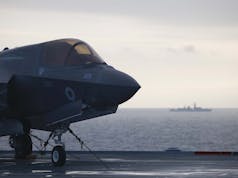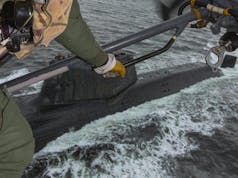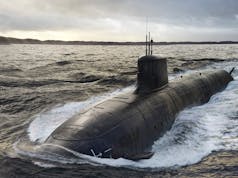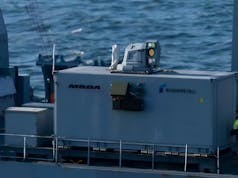The Ministry of Defence is currently seeking options as potential capability upgrades for Sonar 2087, a low-frequency active and passive ‘Variable Depth Sonar’ found on Type 23 Frigates.
The upgrade project is being carried out under the ‘Spearhead Initiative’, the Ministry of Defence say that this initiative “seeks to combine emerging technological solutions with innovative acquisition practices to solve real-world military problems much more quickly than traditional processes would allow”.
Sonar 2087 is a towed array sonar designed and manufactured by Thales at sites in the UK and in France. Sonar 2087 replaces the older Sonar 2031 in the Royal Navy and equips eight Type 23 frigates. The system is also expected to equip the Royal Navy’s future Type 26 Frigates. It is a Low Frequency Active Sonar and consists of both active and passive sonar arrays. Thales describes the system as “a towed-array that enables Type 23 frigates to hunt the latest submarines at considerable distances and locate them beyond the range at which they [submarines] can launch an attack.”
According to an official pre-procurement notice document relating to the upgrade project, the vision statement for “Spearhead Capability Insertion Project for Sonar 2087” is as follows:
“S2087 Capability insertion shall deliver the RN’s key surface ASW sensor for the T23 FFTA. S2087 shall provide persistent operational advantage in the North Atlantic against peer/near peer capability until at least the mid-2030s.
It shall furthermore deliver the persistent ASW sensor to the MTG and shall support pervasive awareness particularly in the North Atlantic through interoperability with other sensing platforms/units and C2 nodes. S2087 Capability insertion will support persistent detection and cuing and combined arms prosecution.
It should deliver a Human Computer Interface (HCI) that is intuitive to operators of all levels of experience and supports maximum flexibility of manning through use of appropriate stimuli to alert watch standers of fleeting SM contacts.”
The aim of the project
The intended outcomes of this project are as follows.
1) Increased lethality of ASW platforms and associated effectors.
2) Improved detection, tracking, prosecution and networking of sensors and platforms.
3) Improved shared awareness of maritime platforms delivering ASW.
4) Improved data handling and analysis.
5) Transforming defence acquisition by delivering increased capability to the front line as
soon as equipment becomes available.
6) Improved UK Prosperity by promoting defence exports.
The pre-procurement notice states that an “Industry Day” will be held to brief on the Spearhead process and provide opportunities for industry/academia to participate.
“The date and venue for this event will be published in due course (currently expected to be 5th December 2022 at HMS Collingwood, Gosport, but may be subject to change).”
More ont his when more comes out!













Crew permitting but could you put sonar 2087 onto the T31s? Sensible or not?
Hmmmmmph, I won’t mention the old T23 photo above…lol…but it’s a nice angle. Very good news of the sonar upgrades. This program can also be extended to the T45s and even T31s later. Surely the more updated sonars the RN has the better? And upgrades to Merlin’s, of any remaining Merlin’s coverted to ASW and UAVs for the RN. Maximising the potential and lethality of what we’ve already got. Can anyone advise if the carriers have sonars?
* just to add, as is a towed array type sonar upgrade then some other sonar upgrade best suited to the T45/31s.
T45 and T31 are too noisy for 2087 to be effective. Better using off board USV that can distance from the ship.
Good point Jim. I saw there is an ASWvariant of the T30/A140, but maybe this towed as you say.
“of any remaining Merlin’s coverted to ASW”
There are none to convert. Other Merlin are with the CHF and not for ASW.
So …
New COTS modern hard drives, COTS Servers, better COTS computer processors, new COTS GUI displays, new COTS graphics cards, new COTS network cards and some new computer algorithms.
Basically they are upgrading to the latest model Alienware! 😀
Going for COTS and open architecture shows its worth. Avoid single purpose made, low manufacture runs of individually designed circuit boards.
It probably also helps that the USN has decided that 2087/CAPTAS 4 is the future for towed array sets on its new frigates having binned their own attempt at a active /passive set Raytheon’s AN/SQS-62 Variable Depth Sonar…they couldn’t make it work after having spaffed north of 50mil USD on it.
They mention networking twice, so not just new COTS network cards, but extra ones too?!
Interesting about the USN choosing 2087 over their own- must have been a tough choice there in terms of choosing the non-US product. I know it’ll be built there, but they generally like to keep the IP stateside too, don’t they? Please tell me that 2087 is ITAR-free and therefore we aren’t beholden to them in any way…
Open architecture means that these can find their way to Oz and Canada too, right, from the perspective that they’ve got T26/GCS hulls with American CMS?
Good to see the US making a sensible procurement decision.
Yes but are they buying from UK manufacture or building their own after we give them entirely our IP developed at our defence budget cost? If given free of charge what we getting in return?
Hypersonic missile technology/ stand off attack missile would be nice.
Fincantieri pushed the USN to face the reality:
1 -Raytheon sonar was being delayed and Fincantieri warned that without it now there will be no ship in schedule.
2- CAPTAS 4 is already in Italian FREMM
US tried a Raytheon design the AN/SQS-62 Variable Depth Sonar for four years. However it was found to be inherently hydrodynamically unstable (i.e. it was as stable as a shopping trolley with a broken wheel).
Typical. 🙄
As soon as the yanks buy something from you it gets automatically covered by ITAR and they then control what you can and can’t do with it. It’s a real bummer.
That sucks…!
I guess, when it comes to ASW specialist sonar, there aren’t many other buyers than the US and 5 eyes partners- so less of a concern about nixing foreign sales due to ITAR blocks.
Yep. It sucks. You’re right about the 5 eyes stuff. But that applies more to information sharing and operational procedures, data libraries, etc, than to the actual kit itself. Remember 2087 is basically CAPTAS4 which is a Thales product and a lot of it developed in France. What tends to happen is that very rarely are you stopped from selling the actual kit. Rather the kit is somewhat ‘doctored’ to perform slightly below the NATO/5 eyes standard. Easier to do these days with so much software dependant kit. In the case of sonar, some low level ‘noise’ can be injected into the electronics to reduce the system’s fidelity. Turning it from a bloody good sonar into just a very good sonar. Less critical with active systems than passive ones. Also you can play with bearing discrimination and other parameters.
Wonder whether the French will be eligible for the enhanced version? 🤔😳😉
Well they’ll have to codevelop parts of it
Some business practices we borrowed from the Mafia. Took many years to perfect, billions in consultants fees, POs allies to no end…
The American sonar for the Constellation class (and for the ASW module for the LCS program) was supposed to be the Raytheon DART, but it had stability issues and electronics failures that would have needed more time to figure out. The Constellation program is on a tight schedule and can’t wait around for new tech to be developed, so the decision was made to go with the already mature Thales CAPTAS 4.
The US military actually uses a lot of foreign systems. When I was in the Marines for example we used Italian pistols, Belgian light and medium machine guns, Swedish anti-armor rockets, and don’t forget Harriers, which are still in service. In the Navy they use Australian decoys, Thales helicopter dipping sonars, and British training jets. Also, half the LCS ships are of an Australian design and are built by Austal USA, which is an Australian owned yard in the US.
As an aside, the decision to go with the FREMM as a parent design was also about the timing. (That and FIncantieri invested significant amounts of money to upgrade 3 yards in Wisconsin to build the class in the US.) I’ve seen a lot of comments here about the Type 26 as a candidate for the Constellation class, but that didn’t and won’t happen, just due to timing. The FREMM was already a known design, while the first Type 26 isn’t in the water yet. The Type 26 will undoubtedly be a great design, but the USN just couldn’t wait for it to mature. No hard feelings, there isn’t any greater feeling in the US for the Italians over the British, it’s just about the timing and that the USN is once bitten twice shy about developing “transformational” new ships.
Anyway, if I understand it correctly Thales bought AAC, which will be making the CAPTAS 4 in the US for the Constellation class.
Another (former?) American serviceman in the comments! Glad to have the different perspective. Just to be very clear, because I was commenting on a very specific subject: I like the US, I worked in Texas for a few months and with a number of Americans for years- great place and great people. I’m also proud of the shared military history that we have, and am glad that is continuing. What I’m not a fan of is the protectionism in place on US miltiary IP and equipment (ITAR being just one example), which helps push US products globally at the expense of British products. But hey, can I honestly say that the UK wouldn’t do the same thing if the situation was reversed? One could argue that the British Empire worked on a not dissimilar model of ensuring British produced products were the ones consumed in the colonies.
The FREMM decision was the right one for the USN at the time, and no one can just keep on waiting for the next greatest design to arrive- they’ll get good mileage out of the Constellation. No hard feelings at all!
Believe your assessment is correct. Different thread discusses possibility of revisiting choice, at a future date, for a second contract. Deemed a low, but non-zero, probability event. Stranger tidings have occurred…
Intrigued by the possibility of requirements and timeline overlap between DDX and D-83 classes. If compatible, could become a massive program under the auspices of AUKUS…🤔😳
Possibly, but the RN seems to be doing everything possible to avoid using US systems and seems to like European systems. No judgement on my part, the RN should buy what they want. DDG(X) is still in the infancy of it’s requirement phase, but the USN has already decided that it will have SPY-6, AEGIS, MK-41 cells, possibly some larger cells for hypersonics, RAM launchers, etc. Maybe the two classes could share a hull design and propulsion though.
Apology, should have been more explicit in comments re DDG(X). Meant hull form and propulsion. Doubtful parties would ever agree to harmonize requirements for sensors, weapon systems, CMS, etc.
Random chance dictates an occasionally intelligent procurement choice. 👍
The other networking will be off ship. So taking data from other sources via data link and inputting it into the sonar system where it can be number crunched to give you detection data.
interesting, making it more the centre of the hub, so to speak.
I may be reading too much into that, but does that imply an eye on future unmanned ASW systems underwater and to replace Merlin, that wouldn’t necessarily have the capacity for that level of data analysis? Or is it purely the stuff we already have?
I was quite surprised on T23 TV program when the sonar broke just how much we saw of it.
I identified 3 of the PCB’s doing nothing more than a web search with a bit of intuition and general electronics knowledge. They were all COTS.
I do agree that the need for loads of bespoke boards is pretty limited as the clever stuff is in the software.
So many of the bits of sonar and radar back ends are straight out of scientific research kit. That said, one of the reasons for non COTS, was that it made the equipment harder to reverse engineer. The flip side being that if you are putting a row of COTS boards Together proof of concept can be had really quickly.
By any chance does that mean USN would buy from Thales UK, France? Or follow the default and insist it’s manufactured in US, as I’d anticipate Gunbuster?
ST2087(TA NB system) is a TUS UK designed sonar along with ST2050 bow system which is also UK designed.
No idea if it will be built in UK or USA?
OK, thanks for the additional info, Deep.
One does wonder why certain technocrats insist on attempting to reinvent a perfectly acceptable metaphorical wheel. Morons.
Presume this effort will improve all of the “ilities.” Bottom line performance as well?
The defence part of defence spending in any country is small compared to the market value of the business that sold the gullible in uniforms the proposal. It is similar to large infrastructure projects; one looks at the result and wonders where all the money was ‘spent’.
It’s not mathematically possible for the market value of a business to exceed the amount of defence spending allocated to it. At least, not sustainably. The market value of a business is quite simply the sum of its expected revenues. When it ceases to receive revenue, its market value drops to zero. The market value of a business may appear far more than it actually is, which is natural as we have yet to develop the art of seeing the future. But in the end, on a day of reckoning, the sums are always settled up.
Businesses receive a lot less than all of the UK’s defence budget. A very significant amount goes to wages and pensions.
‘1) Increased lethality of ASW platforms and associated effectors.’
How is this outcome going to be achieved? Whilst very welcome the sonar upgrades enhance seeking and finding but not lethality.
Additionally are torpedo launchers on ships back in fashion?
If you cant find something you cant fire at it.
If you’re in a Type 31 you can’t see or fire at it.
“Type 23 frigates will have electronic upgrades to Seagnat, a system which safeguards the vessel against incoming missiles by firing a variety of decoys to defeat incoming missiles. Some ships will also undergo a further technical upgrade to their Magazine Torpedo Launch Systems – a close range, quick reaction Anti-Submarine weapon system which launches torpedoes from tubes mounted in the vessel’s magazine.”
Reported in UKDJ Oct 7 2022.
T23 has MTLS which is getting upgraded to overcome obsolescence issues . It had one years ago when I maintained it for exactly the same reason. The new upgrade I beleive makes the computer system , (not so much the tubes which are sort of universal already) more weapon friendly in that it will be easier to put different weapons in it without making physical system changes.
What’s MTG?
Maritime Task Group?
Could be. Thanks.
That’ll be ready about 2045 then…
We produce excellent sonars. T23 remains a very capable ASW platform and I’m sure that T26 will be even better. The Astute’s are also excellent ASW platforms but we have far fewer SSN’s than we have missions for them.
The lack of ASW capability in other escorts is a serious concern. T45 is noisy with a basic sonar which is reportedly no longer manned. T31 will have no sonar and has non-rafted diesel only propulsion which means that they will be a less capable ASW platform than the 20+ year old T23 GP’s that they are replaced.
This is combined with the T45 and T31 routinely carrying Wildcat which has very limited ASW capability.
We are moving from two thirds of our escort fleet being capable or very capable ASW ships to only 40%. At a time when the undersea threat is increasing in terms of Russian investment and aggression and with the proliferation of capable diesel submarines to unfriendly countries, that’s a scandalous reduction in capability.
Not wrong but I suspect the idea is that drones will do much, maybe most of the detection job by the end of the decade, probably much of the kill job too assuming the MoD get their act together of course.
It would surprise me if the T31 routinely carries any kind of rotary, given the current stage of construction, so why you think they’ll only be carrying Wildcats five or ten years down the line, I’m not sure.
I’d guess they’d be carrying the 3-ton Leonardo RWUAS drones (Proteus), which are aimed to carrying sonobuoys and possibly dipping sonar, and should be available as a demonstrator around 2025. There’s every chance they’ll get XLUUV with KraitArray thin-line sonar, which I suppose becomes variable depth in deeper waters. Add in a networked system and the Wildcat, which can launch Stingray torpedoes, and I think you can have a reasonably credible ASW facility.
SB stated DGs will be rafted on T-31, although rest of machinery may not have same degree of acoustic attenuation. Absolutely agree preferred sol’n would be a build of 13+ T-26s, however, bean counters have a vote. Real issue will surface (pun intended) in the 2030’s when an upgraded, scum-sucking slimeball ChiCom SSN fleet comes calling in the NA. 😳
The problem is also that Russia will heavily invest in submarines for the future since it saw how its surface force have no chance.
Drones.
11m Workboats, the same sort used for MCMV work have already trialled a thin line Krait array for passive ASW. (This was by the same team, SEA, working on MTLS systems) As the T31/T32 are going to have a lot of modular fits, expect this to be one of them. You can then stand the passive array off board , away from the mother ship , use two together to triangulate targets, you could even use them for bistatic receiving from a transmitter on another unit such as a T23/26
How noisy is a 1km line with a set of transducers on the end being dragged behind a boat?
Always wondered how much self-induced noise is generated.
Arrays have a VIM – Vibration Isolation Module that decouples the array from the tow wire. The depth that you deploy an array at is dependent on two things
If the boat is moving slowly at a long stay the array will be deep.
If the boat is moving slowly at a short stay the array will be shallow
You dont want to tow for a long period at a fast speed as its easy to stretch and break the array.
So slow speed with varying tow lengths to determine array depth is best and this reduces any self induced noise.
Cheers GB, undersea warfare is not my forte. I had wondered if the cable and array could generate sufficient audio noise to be detected. As you say it proportional to the sub’s speed.
I wonder if they’ve thought of using a deployable unmanned underwater vehicle (UUV) from the sub. That is connected by cable for command guidance, power and data. That could deploy its own towed array?
This should be able to give the advantages of combining two arrays. Therefore better sensitivity, range and bearing information. Would be even better if there were two UUV operating either side like “loyal wingman”, where the you can then use triangulation of signal strength to work out passively a targets range and bearing. It will also give you good target height information. Especially if the UUVs can alter their heights relative to the sub.
Just a thought….